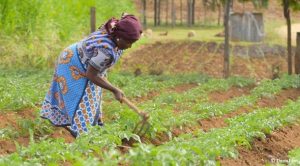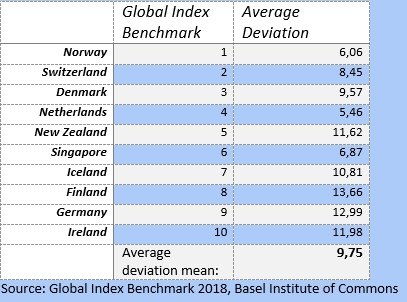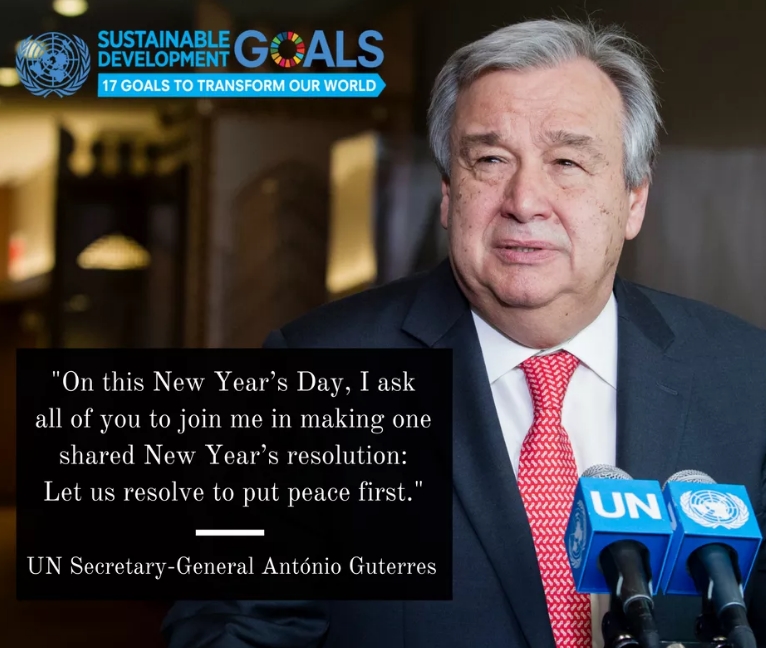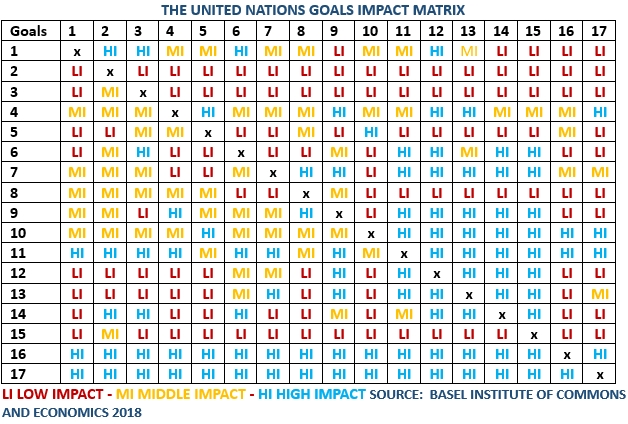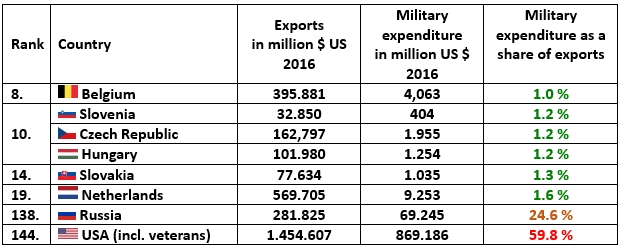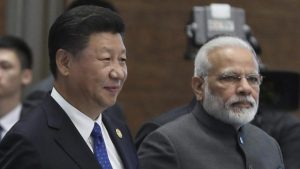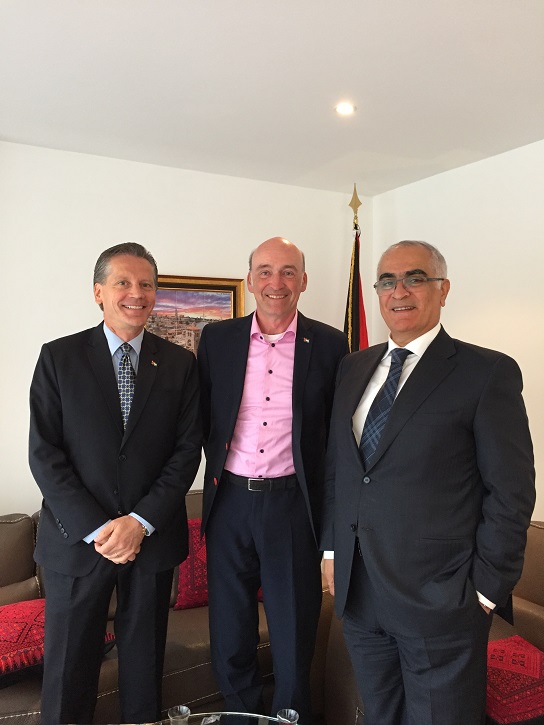When the 17 United Nations Sustainable Development Goals (UN SDGs) have been launched in 2015, most of the amazed supporting donor countries from the OECD believed that the Goals were about increasing a bit their Official Development Assistance (ODA) – and as well the capital for the Development Banks. Even a UN Sustainable Development Fund has been launched – with the disruptive size of $ 70 million (not bn!) when we created the chart presented here in early 2018.

For many countries and IGO SDG Goal 18 is the most important one: Zero Action
For quite a lot rich countries to financing the Global SDGs isn’t any issue. They regard the 17 UN Goals as something to implement in their National politics and started initiatives to meeting the SDGs in their country such as our own country Switzerland. And so the rich countries go to protecting their biodiversity and clean water, claim Gender justice and support campaigns to avoiding waste. In Switzerland of course.
Other countries, take Germany, see their contribution by calling others for action: https://sdgactioncampaign.org/de/. The German Bertelsmann Foundation and the US billionaire Ted Turner successfully launched an Index to measuring the progress of the SDGs and established a private SDGs network, headed by Jeffrey Sachs. They call this private network UNSDSN. Many people believe it to being part of the UN community. Unfortunately this network provides zero funding to any of the SDGs but sends a message to the poor countries: ‚Go increasing your GDP! We show you how: by free trade.‘
How comes? Well, the Bertelsmann Index creators used indicators that all depend entirely on GDP, as we can see in the Global Index Benchmark, that compares the rankings of countries in the SDG Index with their ranking by GDP.
Lots of lyrics from Washington and New York – zero figures, zero execution
In late 2017 the United Nations started the Inter Agency Task Force (IATF) on Financing for Development, an initiative to improve both the knowledge as well as the funding of Development in general, of the 17 SDGs in special.
In early 2018 the first report on Financing for Development has been released. It is mostly based on the annual ‚Global Outlook‘ lyrics of the World Bank, the IMF, UNCTAD, UNDP and WTO, the so called ‚five stakeholders‘ of this new working group. When we had the last meeting of the IATF on October 29th in New York, several delegates from countries criticized the lack of figures and country samples. But if you read the statement of the United States of America delegate to the 2018 report, Mrs. Stefanie Amadeo, you will quickly understand why the report doesn’t mention any countries or figures. Quote:
‚The United States rejects any attempt to interpret the language in Paragraph 5 to promote state ownership in the economy, or to suggest that governments may deprive private interests of wealth or resources without compensation in accordance with international law or otherwise fail to observe a State’s legal obligations.‘
This is quite funny, because with public expenditures of $ 790 billion per year for military, the United States are the biggest governmental spender in the economy worldwide. It’s also funny that Mrs. Amadeo refers to ‚international law‘. As far as we can say in October 2018, none of any of the international laws is respected by the United States of America.
But the document shows, how difficult it is for the IATF on Financing for Development to release any position featuring the size, the sources and of course the governance to implementing the Finance for Development.
Lessons from the HFCs case in 1987 – Global commitments can work
So we – the Basel Institute is part of the Civil Society activities within the IATF on Financing for Development see: https://developmentfinance.un.org/iatf-2018-report-preparatory-materials – have to find ways to creating a decision base on Financing for Development.
That decision base may have three central points of evidence:
- The Global costs of the 17 UN SDGs including the consideration of their interlinkage(s)
- The Global sources to financing these costs including transaction costs such as for interests, pollution, war and military
- The existing or non-existing Global mechanisms to provide the Financing for Development
It’s a bit like with the Global HFCs case that has been successfully resolved in the Montreal Protocol in 1987: we may know from experts what do to, but doing it is a different thing. By chance in the HFC case it happened and even the US and China abolished the HFCs.
 So here we get a first overview on the estimated annual costs. The general costs in any case start at $ 2.5 trillion per year (UNCTAD). That sounds a lot, but is e.g. the GDP of Germany only.
So here we get a first overview on the estimated annual costs. The general costs in any case start at $ 2.5 trillion per year (UNCTAD). That sounds a lot, but is e.g. the GDP of Germany only.
Due to the interlinkages, the single SDGs are hard to estimate. The World Bank’s study on achieving clean water all over the World (SDG 6) claims $ 150 billion per year needed. That’s not a lot when we compare it with transaction costs such as the $ 1.69 trillion for military according to Stockholm’s SIPRI.
To overcoming poverty (SDG 1) may be resolved by a basic income for the remaining 600 million really poor, that the Basel Institute calculated wit 132 billion Dollars per year. That means: 220 Dollar per head and year. A similar approach has been taken by the WHO: they estimated $ 58 per head and year to achieving SDG 3 (Health and Well-Being). If we take a target group of two billion people in need of this help, we reach $ 1.16 trillion per year.
So we may not know enough on the costs, but as we learn in the following chart, the instruments to financing the costs such as ODA and Development Banks are not made for such a Global issue: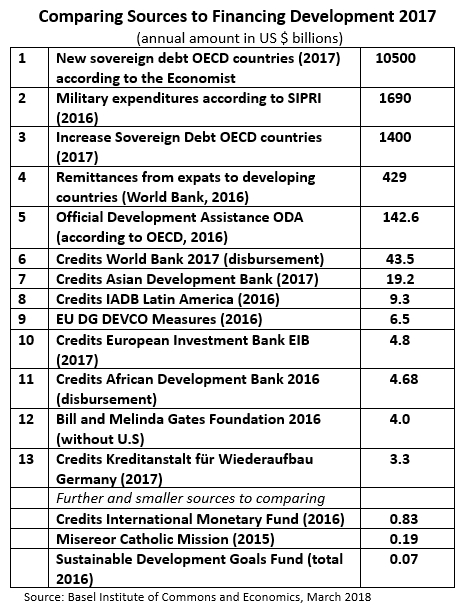
The most surprising figure here – even and especially for experts – may be the 10.5 trillion new debt per year the OECD countries pick up. This figure appears when we divide the total debt of $ 63 billion by a maturity of six years. Of course neither the OECD, nor the countries, nor World Bank and IMF feature this reality of raising sovereign debt year by year (Rank 1).
Nevertheless the OECD considers what they call ’new debt‘, which is only the increase of the total debt (Rank 3). As well rank four rarely appears in official statistics: the $ 429 billion expats send to their families in developing countries every year.
The ODA, that still is regarded as the major source to achieving the SDGs, is only 1.4 per cent of the new sovereign debt. The Development Banks as well deliver quite few to the 17 Goals – especially when we consider their focus on big infrastructure projects such as roads, harbors and airports, that may create transaction costs for pollution, interests and security, that are at the same size than the investment.
When it comes to the NGOs, that drive the public picture of Financing Development through images of poor children in rural areas, we see how small their contribution is. The Bill and Melinda Gates Foundation accounts for $ 4bn a year, but how much of this money goes to vaccination and pharmaceutic products, consultancy and marketing for vaccination programs?
The poorest source to Financing for Development unfortunately is the UN Sustainable Development Fund with $ 70 million ‚invested‘ the end of 2017.
What to do instead of complaining: a $ 10 billion SDGs Fund
So what is Basel Institute doing to better the situation then instead of complaining? As you can read in the article of Germany’s Handelsblatt, Basel Institute has talked to quite a lot institutional investors that currently do not allocate in any of the countries in need. As a result we started to  developing a $ 10 billion fund that invests in the SDGs. The knowledge base comes from our worldwide Social Capital Assessment, that for the first time assesses the three indicators on co-financing public goods and to investing in local small enterprises and cooperatives. So the fund will focus on these three indicators and provide capital at a very low interest rate, that allows local companies and cooperatives to invest in a mid-term perspective.
developing a $ 10 billion fund that invests in the SDGs. The knowledge base comes from our worldwide Social Capital Assessment, that for the first time assesses the three indicators on co-financing public goods and to investing in local small enterprises and cooperatives. So the fund will focus on these three indicators and provide capital at a very low interest rate, that allows local companies and cooperatives to invest in a mid-term perspective.

Which obstacles do we have to overcome if we’d like to directly fund on the SDGs?
- NGO fear that they lose control over their ODA projects and refuse to collaborate and of course fear any calculation of their transaction costs, e.g. for administration and security
- Development Banks fear to losing the political control they implement with their projects through bilateral and multilateral agreements on e.g. ‚free trade‘, ‚governance‘ and ‚rule of law‘. Further they have to follow the political agenda of their owner countries that will not consider the SDGs 1, 10 and 16.
- Development ministries delegate Financing for Development to their collaborating Development Banks and the NGOs that execute the local projects. Some of the SDGs – especially SDG 1, 10 and 16 – are not in their agenda or a regarded as a duty for ‚private‘ actors. So they launch conferences on PPP for Financing Development instead of dramatically increasing their own budget.
- UN agencies fear the review and assessment of their small funds and of course a confrontation with the major donors of the UN which are the OECD countries, that are called to sharing their access to capital.
- Governments fear to losing the political control that is connected with ODA and Development Credits while the projects have to apply for funding at governmental agencies.
So Basel Institute will provide the figures for the three new indicators in the beginning of 2019, continue to fundraising the SDGs Social Capital Fund and of course to contribute to the IATF on Financing for Development.
The new report of Basel Institute will hopefully be ready and published by the end of November 2018. Of course you can directly contact me in case of questions or offers to collaborate. Your Alexander Dill, Director, mail: dill(ad)commons.ch, phone: 0041 61 261 35 21
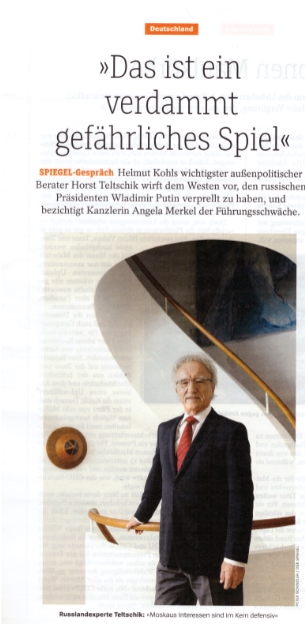 Since Crimea returned to Russia, NATO – driven by the United States – is imposing ongoing threats on Russia. While few European leaders keep good relations with Russia (reducing it on the person of ‚Putin‘) – sanctions and boycotts damage not only Russia but at first Ukraine and neighboring countries such as the Balkans, the Baltic, Bulgaria, Poland, Romania and Greece. The damage of the NATO politics is at around € 400bn per year only in trade. If we include the damage caused by the military expenditures of the NATO countries we may easily reach € 1.5 trillion per year.
Since Crimea returned to Russia, NATO – driven by the United States – is imposing ongoing threats on Russia. While few European leaders keep good relations with Russia (reducing it on the person of ‚Putin‘) – sanctions and boycotts damage not only Russia but at first Ukraine and neighboring countries such as the Balkans, the Baltic, Bulgaria, Poland, Romania and Greece. The damage of the NATO politics is at around € 400bn per year only in trade. If we include the damage caused by the military expenditures of the NATO countries we may easily reach € 1.5 trillion per year.